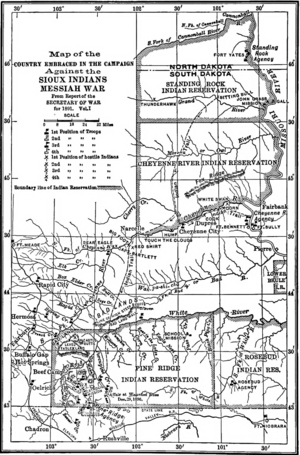
Back Guerre de la Danse des esprits French Geastedûnsoarloch Frisian Războiul Ghost Dance Romanian Война Пляски Духов Russian Ghost Dance Chiàn-cheng ZH-MIN-NAN
This article includes a list of general references, but it lacks sufficient corresponding inline citations. (October 2021) |
| Ghost Dance War | |||||||
|---|---|---|---|---|---|---|---|
| Part of the Sioux Wars | |||||||
 "Map of the country embraced in the campaign against the Sioux Indians Messiah War" (1905) | |||||||
| |||||||
| Belligerents | |||||||
|
| |||||||
| Commanders and leaders | |||||||
| Casualties and losses | |||||||
|
| ||||||
|
Native American losses include civilian casualties. | |||||||
The Ghost Dance War was the military reaction of the United States government against the spread of the Ghost Dance movement on Lakota Sioux reservations in 1890 and 1891. The United States Army designation for this conflict was Pine Ridge Campaign.[1] White settlers called it the Messiah War.[2][3] Lakota Sioux reservations were occupied by the US Army, causing fear, confusion, and resistance among the Lakota. It resulted in the Wounded Knee Massacre wherein the 7th Cavalry killed over 250 Lakota, primarily unarmed women, children, and elders, at Wounded Knee on December 29, 1890. The end of the Ghost Dance War is usually dated January 15, 1891, when Lakota Ghost-Dancing leader Kicking Bear decided to meet with US officials. However, the US government continued to use the threat of violence to suppress the Ghost Dance at the Pine Ridge, Rosebud, Cheyenne River, and Standing Rock reservations.
- ^ Greene, Jerome A. (January 31, 2007). Indian War Veterans: Memories of Army Life and Campaigns in the West, 1864–1898. Savas Beatie. p. 193. ISBN 978-1-61121-022-4.
- ^ "History 605: Wounded Knee". SDPB. Retrieved October 30, 2022.
- ^ "Philip F. Wells Collection | South Dakota State Archives ArchivesSpace". sdarchives.lyrasistechnology.org. Retrieved October 30, 2022.